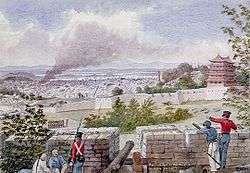Opium Wars

The Opium Wars were two wars in the mid-19th century involving Anglo-Chinese disputes over British trade in China and China's sovereignty. The disputes included the First Opium War (1839–1842) and the Second Opium War (1856–1860). The wars and events between them weakened the Qing dynasty and forced China to trade with the rest of the world.[1][2]
First Opium War
The First Opium War, during 1839–1842, was concluded by the Treaty of Nanking in 1842. The treaty ceded the Hong Kong island to the United Kingdom in perpetuity, and it established five treaty ports at Shanghai, Canton, Ningpo, Fuchow, and Amoy. Another treaty the next year gave most favoured nation status to the United Kingdom and added provisions for British extraterritoriality. Then France secured concessions on the same terms as the British, in treaties of 1843 and 1844.
Second Opium War

During 1856–1860, British forces fought towards legalization of the opium trade, to expand coolie trade, to open all of China to British merchants, and to exempt foreign imports from internal transit duties. France joined the British. The war is also known as the "Arrow War", referring to the name of a vessel at the starting point of the conflict. The Arrow War resulted in a second group of treaty ports being set up; eventually more than 80 treaty ports were established in China, involving many foreign powers. All foreign traders gained rights to travel within China.
References
- ↑ Taylor Wallbank; Bailkey; Jewsbury; Lewis; Hackett (1992). ""A Short History of the Opium Wars" (from: Civilizations Past And Present, Chapter 29: South And East Asia, 1815-1914)".
- ↑ Kenneth Pletcher. "Chinese history: Opium Wars". Encyclopædia Britannica Online.